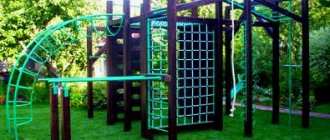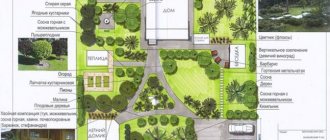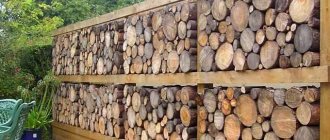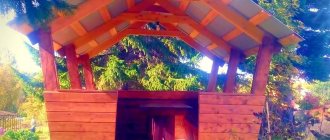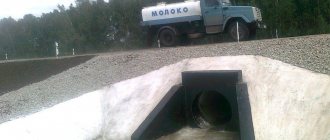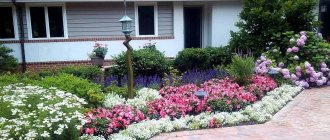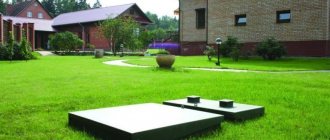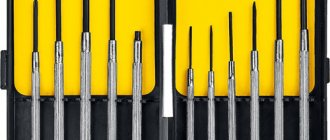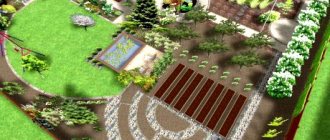Design is painstaking work that helps create a comfortable and functional area in the country. In landscape design, the layout of a vegetable garden seeks to organically place the necessary plants in zones. To make the beds look beautiful and well-groomed, you need to correctly distribute the usable area.
A suburban area should be used to its maximum benefit, not forgetting its aesthetic appeal. If you mark the elements of landscape design on a diagram, it is easy to notice strengths and weaknesses. The intensive work and time spent will pay off in the future with a bountiful harvest and a spectacular appearance.
Greenhouse in the garden Source www.greenduck.com
Planning
First you need to decide on the simplest thing - how many square meters do you want to allocate for the future vegetable garden?
The standard solution is to allocate about three to four acres, but here different options are possible, which depend on:
- on the number of family members;
- area of the site;
- availability of sufficiently lit space;
- the desire of the owners to arrange other useful and beautiful things on the site such as flower beds, gardens, gazebos, greenhouses, garden decorative sculptures, etc.
So it turns out that the layout of a vegetable garden at a summer cottage depends not only on the number of acres, but also on the desires and capabilities of family members.
Bed sizes
There are no strict rules establishing the size of beds. You have to focus on expediency and common sense.
Width
Thus, the width of the plantings is determined based on whether it is planned to approach them from one or both sides. If only with one, the width should not be more than 500 mm. This way the gardener can easily reach the opposite edge, and this is necessary for normal care. The beds, which can be approached from both sides, can be twice as wide: 900-1000 mm. It is optimal that the worker can reach with his hand a little further than the center of the plantings. Then it will be convenient to care for them. The length can be any. Sometimes multi-meter structures are made, dividing them into small fragments with different vegetables.
An important point is the width of the tracks. They are made so that it is convenient to walk, water and care for crops. Minimum width 350-400 mm. The choice also depends on the variety. So, for carrots, greens or beets, a minimum width will be enough. For beans, peppers, tomatoes or eggplants, it is better to make them wider.
Height
The height also varies. It is believed that in warm regions raised ridges need not be made. Plants are placed at ground level or even slightly deeper. In cold areas, plantings are raised to a height of 100 mm or higher. This way the soil mixture warms up faster, which is important for areas of unsustainable farming. Raised structures usually have a frame made of plastic, boards or old slate. But this is optional.
Plant placement scheme, which is important to consider when planning
When planning sizes, take into account the plant placement pattern. This is how it looks for the most popular varieties.
Form
The shape of the ridges can be any. For some crops, for example strawberries, vertical structures are chosen. If everything is calculated correctly, it feels great in vertical plantings and bears fruit abundantly. The traditional shape for garden beds is a rectangle. But if desired, you can make triangular, square or complex polygonal structures. They will become a real decoration of the site. The photo shows several options for such designs.
Start
Never try to do everything at once. Don’t be afraid to start small - a successful start will give you confidence in your abilities and increase motivation for further work.
In the first year of gardening, we recommend planting radishes, cucumbers, onions, and sowing lettuce seeds. It seems like a simple set, but it’s quite enough for preparing salads, and it won’t take a lot of time and effort to work in the garden.
Advice! Don't try to grow tomatoes and strawberries the first year! These are capricious crops that require careful care and certain skills.
Land preparation
Initially, the area that you have chosen for the beds needs to be processed, dug up and plant debris removed. If there was previously a building at the chosen location that you demolished, you need to remove all construction debris, and there will be a lot of it: glass, wood chips and nails.
Ideally, of course, bring new soil to such a site, because there is a possibility that the soil is no longer fertile.
The most important thing is to prepare the bottom layer of soil. If it is dense, then moisture will accumulate on it all the time, which is why the rhizomes of plants can rot. In order to loosen the soil, it is better to use a cultivator - this will be difficult to do manually. And give some soil for testing, so you will find out the acidity level, because there is a possibility that the soil is not suitable for growing crops.
Aesthetics
As the great Faina Ravnevskaya said, “Beauty is a terrible power!” It's hard to disagree with this. We must try to “kill two birds with one stone” - get healthy and necessary products, and please the eye with the beautiful design of the site.
The right design style will help you achieve such harmony: minimalist or French.
Let's talk about the features of these stylistic trends in more detail.
Weeding
“Before you develop the site, you need to tear out as much as possible everything unnecessary by the roots. This can be easily done with the help of herbicides, which penetrate into the plant with cell sap and poison it. The waiting period is indicated in the instructions. For some herbicides it is a week. During this time, they manage to clear the soil of the above-ground parts and roots of weeds and disintegrate. Then there is no poison left, and feel free to plant useful plants. You can also pull out weeds by hand. Moreover, the better you prepare the area, the less weeding there will be later. It’s also worth mowing the plots of careless neighbors - if they have waist-deep weeds there, then they are not only a fire hazard, but also produce weed seeds that fly into your garden,” he says.
Green oasis. How to choose irrigation systems for your garden? More details
Monastery courtyard
Proponents of minimalism choose simple, clear geometric shapes to decorate their garden. For such people, a rectangular garden layout is perfect.
Straight lines combine beautifully with geometric shapes, and cobblestone paths not only attract the eye with their simple beauty, but also provide convenient access to the beds.
Note!
Trellis for grapes? do it yourself - ready-made solutions for the garden plot. Instructions + 120 photos of options for the correct trellis
The best ideas for a summer cottage: 110 photos of exclusive ideas and new products in landscape design at a summer cottage
- House for a well: a step-by-step master class on how to make it yourself, recommendations from craftsmen with simple work patterns
Another advantage of the ascetic design is that there is room for a small pond, miniature benches and low-growing bushes.
Zoning when planning garden and berry plantings
The layout of a garden combined with a vegetable garden requires a clear division into functional parts. The front entrance is the face of the composition, so there is a lawn, low trees and benches here. To develop the territory, you will need recreation, planting and utility areas.
Plants
The boundaries between the functional parts of the garden and vegetable garden are planted with shrubs. Gooseberry, raspberry and currant hedges are trimmed to maintain their decorative appearance. Between the zones there are flowerpots with large plants. Screens and trellises with climbing crops will help create a beautiful fence.
Low open fences up to 40 cm in height in landscape design are planted from thuja, boxwood and juniper. A border separates a playground, vegetable garden or garden. A solid wall up to 1.5 m is erected from dwarf trees and bushes:
- barberry;
- Japanese quince;
- steppe almonds.
Fast-growing sunflowers and sloe will help create a high boundary between zones. Large varieties of flowers are used to form a green fence. Climbing perennials (roses, clematis) look impressive on trellises and arches. Over the course of the season, decorative beans and nasturtium will cover the composition with the screen.
Colors
Zoning in the landscape design of a garden is carried out using shades. Orange and blue colors are suitable for the playground, and pastel shades for relaxation. A composition of red and green lifts your spirits.
Paths
Paths not only connect different parts of the garden, but also help draw boundaries between zones. The paths from the gate to the house are made of paving stones or tiles with clear geometric shapes. Openwork solutions are used for the garden square, and colored gravel is used for the beds and flower beds. In landscape design, the imperfections of the territory can be easily masked with winding paths.
Raised beds in wooden forms Source autogear.ru
Height
When arranging a garden, dividing functional parts by a height difference looks impressive. Flowerbeds and beds are laid out at different levels. The raised space between zones is lined with stone, tiles or mosaics. A sunken area with a miniature pond or waterfall is suitable for relaxation.
Raised beds - beauty and lack of weeds Source www.dom-dacha-stroyka.ru
French charm
Would you like to have something similar to the design of the royal Versailles from the time of the Sun King? Then you’ll have to start arranging your site in the French style!
It should be remembered that you will have to determine the central part of the composition, from which triangular beds will extend, forming a hemisphere or semicircle. Symmetry must be observed when designing each element.
More detailed information on how to plan an exquisite vegetable garden can be easily found on the Internet. We will list those elements that will decorate a suburban area in general, and a vegetable garden in particular:
- decorative borders of paved paths;
- miniature fountain;
- curly (topiary) bush trimming;
- garden sculptures.
Important! Low-growing shrubs are suitable for such a garden. They should not “obstruct” the view, and from time to time they “demand” a fashionable “hairstyle”.
Note!
- Do-it-yourself canopy over the porch - choice of materials, types of structures + instructions for making it yourself
- Do-it-yourself bathhouse in the country: expert recommendations, choice of materials, step-by-step description + instructions for DIY construction
- How to sew outdoor curtains for a gazebo with your own hands: step-by-step instructions + 140 photos of ready-made ideas
Tools
“The most basic work at the dacha (from early spring to late autumn) is weeding. For work, you need to choose the tools that make you least tired. The heaviest is a shovel, and the least is a hoe or hoe. Some summer residents add unnecessary work to themselves, for example, digging up trees in the garden with a shovel. Thus, they cause great harm to trees - they destroy the most active small roots. In this place, it is better to weed out the weeds with a hoe or a flat cutter - and the necessary roots will remain intact,” said Andrey Tumanov.
Rules for the location of beds
To get the maximum harvest, you need to properly arrange your garden at your dacha, and for this you must adhere to the following rules:
- choose the sunniest place - all vegetable crops love warmth and the rays of daylight;
- Before sowing or planting, the soil should be leveled;
- if the soil has a slope, then plants should be planted across it (slope), thereby increasing the efficiency of irrigation;
- try to keep the beds the same length (three to four meters) and width (up to 45 centimeters).
Important! Symmetry always improves visual perception and allows for free access to the cultivated area. Do not arrange beds between fruit trees under any circumstances - the shade will not allow you to get a good harvest, and besides, the chemicals that are used to treat the fruit trees may get into the vegetables!
Recommendations for selecting neighboring plantings
All cultivated plants have “class” enemies: insect pests, viruses, bacteria, fungi. At the same time, the enemies differ in different likes and dislikes - some are eaten with pleasure, while others are bypassed a mile away. This is easy to use to protect your crop when planning your garden beds.
Experienced farmers know that beans, spinach and horseradish greatly spoil the appetite of the Colorado potato beetle, which has encroached on potatoes. Celery should not be planted next to root crops - it inhibits their growth. Wormwood spoils the taste of strawberries and wild strawberries.
Another table will help beginning gardeners find suitable bed neighbors:
Neighbor Compatibility
It is not only individual people who cannot find a common language among themselves and accumulate grievances against each other. It must be taken into account that the same thing happens among vegetables! You should adhere to certain rules in order to correctly plan the planting of vegetable crops in the beds and not cause hostility between garden partners. So, next door you can place:
- beans that will repel beetles from eggplants and fleas from cabbage;
- peas get along well with carrots and turnips;
- onions “make friends” with lettuce, cucumber, carrots and Brussels sprouts;
- cucumbers have nothing against being next to white cabbage, corn, dill and garlic;
- parsley will give a good harvest in the company of basil, onions, cucumbers, beans, asparagus and tomatoes.
This is interesting! Most garden crops experience something like an allergy to one or another neighbor, but peppers, pumpkin, asparagus, lettuce, mustard, zucchini, leeks, squash, horseradish, have a very “flexible” character and do not have incompatible plants.
Useful ideas
To make plants feel comfortable in such beautiful, original beds and to reap good harvests, you can use some secret little things. However, little things help a lot in caring for the garden and growing your favorite plants:
- It is good to add hydrogel to the soil of vertical beds - it will not dry out quickly, but will retain moisture longer
- It is useful to plant marigolds, nasturtiums and other neighboring flowers next to vegetables, which naturally protect other plants from pests
- If suddenly there are ants in the beds, you can plant a celandine bush directly into the anthill - the ants will leave
- It’s good to put a net on the bottom of the box beds - moles won’t spoil the plantings
- After harvesting vegetables, it’s good to immediately sow green manure in the beds
- mustard – quickly produces green mass, disinfects the soil, gets rid of wireworms, supplies nitrogen, phosphorus, potassium
- rapeseed - structures and loosens the soil, which helps plant roots breathe and increases moisture capacity
- lupine - gives a lot of green mass, enriches the soil with nitrogen, loosens the soil, repels the larvae of the May beetle, mole cricket and other soil pests with its roots
- vetch and oats enrich the soil with nitrogen and potassium
- next to vegetables, you can plant honey plants in the beds (white clover, coltsfoot, lungwort, mint, lemon balm, borage, phacelia), which will attract bees, which will ensure pollination of flowers to increase the yield
- the mole cricket does not like parsley, marigolds, or calendula; by planting them around the perimeter, you can protect your garden
Organization of watering
In addition to soil composition and good lighting, vegetable crops need moisture. Depending on the region where the summer cottage is located, care must be taken to properly organize the irrigation of the garden.
There must be a water reserve on the site - a water supply system, a well, barrels of water.
You can choose the watering method according to your taste - using a hose or a drip irrigation system.
Important! The presence of groundwater near the surface (a little more than half a meter) will require the design of a drainage system to remove excess moisture.
Other factors
In addition to the degree of illumination and the crops growing in the garden, when planning a site, you should take into account the type of soil, types of beds and terrain features.
Type of beds
It is believed that ordinary beds that do not have restrictions should be located from east to west. This will provide optimal illumination for low-growing crops. The east-west arrangement is also suitable for trellis growing of climbing crops - cucumbers, peas and beans. Plants turn their leaves to the south, receiving “sun vitamins”.
Beds with edges or growing tall crops are traditionally oriented in a north-south direction. This way the plants do not block each other, and moisture is retained between the rows by creating shade.
Features of relief and soil
If you have a pronounced slope on your site, then you won’t have to think about the orientation of the beds to the cardinal points: you will need to set up your garden exclusively across the slope, forming stepped platforms reinforced along the edges. Such an organization will allow you to rationally distribute the usable area of your existing land and prevent water from flowing over the topography.
When planning the orientation of the beds, you should also pay attention to the nature of the soil:
In principle, difficulties with the nature of the soil can be leveled out using agricultural techniques: heavy soils can be “diluted” with sand, black soil and sawdust, and drainage ditches can be organized in wet areas to remove excess water.
Installing high edged beds and mulching will help retain moisture in sandy strips.
It is impossible to say unequivocally how to correctly orient the beds on the site according to the cardinal directions. The choice of garden direction is influenced by several factors:
In general, if you live in the middle zone in a temperate climate, the soil on the site is fertile, and you have the opportunity to monitor your garden every day, then you can orient the beds to your liking.
According to experienced gardeners, the correct location of the beds is 10% of the success of the harvest, and the remaining 90% depends on your work in the garden and proper organization of work.
Source
Photo of the layout of a vegetable garden at a summer cottage
"Shortcuts"
“Tall trees tend to require more care. To perform some work, such as processing and trimming, you have to climb on a stepladder. In terms of profitability, large trees are inferior to short trees. In America, there is a popular saying among farmers: “The higher I stand on my stepladder, the more dollars come out of my pocket.” In the USA, fruit trees are planted no taller than a person. This is done in other countries where there are industrial plantations. Although low-growing trees produce less yield, they can be planted more densely. They will ultimately produce the same amount of fruit, if not more, as tall trees in the same amount of space. Another advantage of “short-growing plants” is that several different varieties can be planted in a small area. “Dwarfs”, “semi-dwarfs” and “super-dwarfs” have a fibrous root system. They lie shallow. Therefore, they can be grown in places where groundwater is high. Ordinary trees will not grow there,” explained Andrei Tumanov.
Sow seeds in autumn
Experienced gardeners know that a large number of garden crops can be sown/planted in the fall.
Advantages of autumn planting:
- In the spring, time is freed up - during this period, gardeners have enough worries related to sowing and planting work.
- Everything that is sown in the fall begins to grow vigorously in the spring, outstripping plants sown/planted after the end of winter. It is possible to obtain earlier harvests.
In the fall, you can sow dill, carrots, cabbage, beets, various flowers for the garden - asters, marigolds, calendula and many others. It is also convenient to plant bulbous crops before winter - garlic and onion sets.
Use the results of scientific and technological progress
Keep your finger on the pulse of scientific and technological progress, which never bypasses agriculture. Along with traditional growing methods, you can use all sorts of progressive advances that simplify the processes of caring for plants.
Among the most popular and effective solutions are a heating cable that warms up the greenhouse soil, artificial lighting, automated watering, automatic temperature control systems and much more.
What does an accurate calculation provide?
Correct orientation of plantings contributes to:
- reducing the number of sick and underdeveloped plants;
- uniform lighting of crops;
- reducing the frequency of watering;
- increase in yield by 10-15%;
- reducing the ripening time of some crops by 3-5 days.
Orientation from north to south with predominantly cloudy days
In addition, some gardeners claim that vegetables grown in the correct planting direction store better.
How to calculate the optimal width
The recommended optimal width of garden beds differs in different sources. The only thing that all farmers agree on is that it should be such that it can easily process vegetables without going into the soil.
Thus, the width of the last strip should not exceed 1 m. Between plantings, there must be passages with an optimal width of 90-100 cm. There is no need to create a distance between the beds, because spreading tops of plants will significantly reduce this area.
Narrow beds according to Mittleider are also popular. This American farmer developed the “ideal garden” system, according to which 45 cm wide beds alternate with 90 cm wide passages. Plants planted using this method receive maximum sunlight and are well ventilated. These factors, together with balanced feeding, guarantee a high yield even in the absence of good weather conditions.
Location in greenhouses
Perennials
“You can make life in the garden easier by growing perennials instead of annuals. It is enough to plant them once and occasionally look after them. If, for example, tulips need to be dug up at least once every two years, then peonies can grow in one place for 20-30 years. There are flowers that require virtually no care: ephemeroids, scylla, Pushkinia prolesciformes, crocuses, galanthus, Golden Ball rudbeckias. Of those plants that can be used as food, Jerusalem artichoke, vegetable or berry physalis, perennial green onions (spring onions, chives, slime, multi-tiered onions) and others are considered unpretentious. Sometimes they just need to be weeded, thinned and fed,” he shared.
It's time to fight. What should a summer resident focus on in late spring and early summer? More details
Buy seedlings with closed roots
All seedlings are divided according to the type of roots, into two large groups - with closed and open roots. The first are trees whose roots are in planting containers (containers).
To plant an ordinary seedling with bare roots, you have to dig holes in advance and put fertilizer in them. Not every tree planted in this way takes root.
Advantages of seedlings in containers:
- may wait a long time to board;
- take root well;
- They are easy to plant - a hole is dug according to the size of the pot, the seedling is watered, removed from it and moved to a new place.
